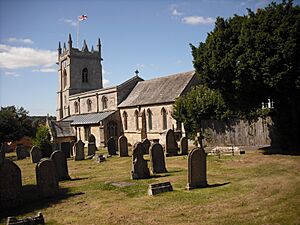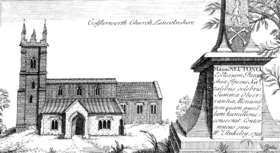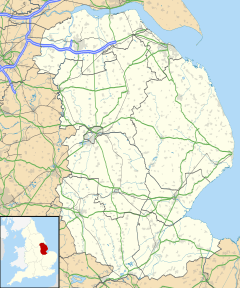Colsterworth facts for kids
Quick facts for kids Colsterworth |
|
|---|---|
 Parish church of St John the Baptist |
|
| Population | 1,713 |
| OS grid reference | SK932240 |
| • London | 90 mi (140 km) S |
| Civil parish |
|
| District |
|
| Shire county | |
| Region | |
| Country | England |
| Sovereign state | United Kingdom |
| Post town | GRANTHAM |
| Postcode district | NG33 |
| Police | Lincolnshire |
| Fire | Lincolnshire |
| Ambulance | East Midlands |
| EU Parliament | East Midlands |
| UK Parliament |
|
Colsterworth is a village in Lincolnshire, England. It is located in the South Kesteven district. The village is just west of the A1 road, about 11 km (7 mi) south of Grantham.
In 2011, about 1,700 people lived in Colsterworth and the nearby hamlet of Woolsthorpe-by-Colsterworth. The area covers about 1,465 hectares.
Contents
Discovering Colsterworth's History
Colsterworth's name comes from an old English phrase. It means "enclosure of the charcoal burners." The village was first mentioned in the Domesday Book in 1086.
Ancient Roots: Roman and Iron Age Times
Colsterworth has a very long history. It dates back to the Roman era. The village is close to Ermine Street, an old Roman road. This road connected London to Lincoln. Another Roman road, called High Dyke, is also nearby.
Archaeologists have found interesting things here. In 1931, a Roman smelting furnace was discovered. This was used to melt metal. In the 1940s, a small Iron Age settlement was found. This shows people lived here long before the Romans.
The village sits on a small limestone ridge. The River Witham flows below it on the western side. An old hamlet called Twyford has now become part of Colsterworth. Its name lives on in some local places.
Life on the Great North Road
Colsterworth became very important in the 1700s. This was because of its location on the Great York Road. This road later became known as the Great North Road. When the turnpike road was finished in 1752, Colsterworth became a busy place.
It was made a "post town." This meant it was a stop for mail coaches. By the mid-1800s, it had a busy coaching trade. There were many inns, sometimes as many as ten! These inns offered food and lodging for travelers. However, a new bypass road was built in 1935. This meant coaches no longer passed through the village.
Today, many of the old coaching inns are gone. Some have been turned into houses or businesses. The White Lion public house is the only one left. It still serves the people of Colsterworth.
Twyford Wood and its Wildlife
About a mile west of Colsterworth is Twyford Wood. This area was once RAF North Witham, an airfield during World War II. You can still see old military buildings there. This includes runways and a control tower.
After the war, trees were planted on the grassy parts of the airfield. This created a new habitat. It is now home to a special group of butterflies. These include the Dingy Skipper and Grizzled Skipper butterflies. They are important to the region.
Woolsthorpe-by-Colsterworth: Home of a Genius
Woolsthorpe-by-Colsterworth is a small village very close to Colsterworth. It is famous for one big reason. It is the birthplace of Sir Isaac Newton. He was one of the most famous scientists in history.
His childhood home, Woolsthorpe Manor, is now a popular place to visit. It is open to the public. The village hall in Woolsthorpe-by-Colsterworth is named after Newton. It was built to honor his memory. Newton was also christened at the St John the Baptist church in Colsterworth. You can find a copy of his baptism record there.
Places of Worship in Colsterworth
St John the Baptist Church

The parish church of St John the Baptist is a very old building. It has been a Grade I listed building since 1966. This means it is very important historically. Parts of the church date back to Saxon times. You can see this in the special "herring-bone" stonework.
The church also has Norman arches. These were kept during later renovations. The churchyard around it has been closed for nearly 100 years. However, the Parish Council keeps it tidy.
Inside the church, you can see a special stone sundial plate. Sir Isaac Newton himself carved it with a penknife when he was just nine years old. It is mounted upside down below a wooden statue of him. Newton's mother and father are buried in this church.
Methodist Church
Methodism arrived in Colsterworth around 1795. The current Methodist church is on Back Lane. It was built in the 1830s. It is part of the Grantham and Vale of Belvoir Methodist Circuit.
Life in Colsterworth Today
Jobs and Businesses
There are not many jobs directly in the village. In the past, many people worked in ironstone mining. This stopped in the 1970s. Today, some local jobs are at a tyre depot and a food cold-store. Farming still provides some work, for example, at the Openfield grain cooperative.
You can also find jobs at fast-food restaurants like OK Diner and Travelodge on the A1 road. Nearby Stoke Rochford Hall is a large conference center that also offers jobs.
Shops and Services
Colsterworth has a few useful services for residents. There is a post office and a medical surgery. You can also find a Co-op store and a hairdresser. Mobile shops, like greengrocers, butchers, and fishmongers, visit the village. There is also a mobile library service.
Community Facilities
The village has several places for people to gather. There is a sports and social club. A village hall is used for events and meetings. There is also a youth center that also works as a nursery for young children. Colsterworth has three playgrounds for kids to enjoy.
Colsterworth Church of England Primary School
Colsterworth has its own primary school. It is a Church of England school. It teaches about 100 pupils from Colsterworth and nearby villages. The school has five classes for children aged 4 to 11.
The school is a "guardian school" for Woolsthorpe Manor. This means it helps look after the birthplace of Sir Isaac Newton. The current school buildings opened in 1973. They replaced older school buildings from the 1800s.
Transport and Roads
The A1 trunk road near Colsterworth was improved in 2010. A roundabout was removed to help traffic flow better. A new road bridge was built over the A1 for local traffic. This helped make the road safer and reduce traffic jams. The village is also on a bus route between Grantham and Witham.
Homes and Local History
Many of the oldest houses in Colsterworth are made of limestone. Newer brick houses were built in the 1920s and 1930s. In the 1970s, a large housing area called Woodlands Drive was built. More recently, in 2009, a new housing development called Newton Grange began.
A village archive group was started to collect memories from local people. This group wants to record the social history of Colsterworth. They also want to note changes in how people speak. They publish books and DVDs. This project has received funding from the Heritage Lottery Funding.
Images for kids
See also
 In Spanish: Colsterworth para niños
In Spanish: Colsterworth para niños



